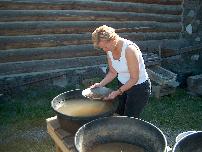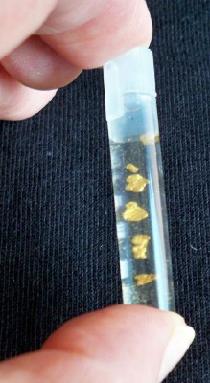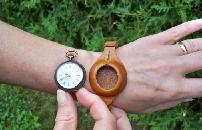
Have you ever wondered what it was like to pan for gold? Some of my books are set in the late 1800s, during the Klondike Gold Rush. On a trip to the Yukon for research, I had a taste of it.
Gold is nineteen times the weight of water, so it naturally sinks to the bottom of the pan. The tricky part is washing away the gravel into smaller and smaller portions while still hanging on to the precious stuff. There’s quite a skill involved. They have a name for the proper technique: dips and shakes. You dip the pan into the riverbed, haul out some gravel, then continue to ever-so-gently shake the loose pebbles free until all you have left are nuggets or flakes. Easier said than done!
My arms started to feel heavy after only a few minutes. Imagine standing there for hours, or days, or weeks, till you found something of value. Another thing I hadn’t counted on was the iciness of the water. In the Yukon, spring thaw occurs in May, but the rivers remain frigid. In the Gold Rush days, I’m sure fingers went numb within minutes of sinking into water. How about a person’s feet and legs?

These are the flakes I came home with. They’re suspended in water. Each flake is roughly worth two bucks, and I found five. Some of the nuggets the stampeders discovered in the Klondike were the size of men’s fists—the largest the world has ever seen. And they were plucking hundreds of them from the riverbeds!
I couldn’t help myself—I brought home a gold pan as a souvenir. I found it interesting that most stampeders who made it to the Klondike did not strike gold, so the pans themselves were more often used to wash socks or to fry fish. I accidentally left mine under an open window earlier in the year. It got rained on, hence rust. But now I feel like a real old-timer! Cost of pan: $12.95. Predicted selling price in future garage sale 5 years from now: 50 cents.
I try to imagine what it must have been like to strike gold big-time, but the closest I come to feeling the excitement is when I watch the TV program, “Antiques Roadshow.”
Do you have any hidden ‘nuggets’ at home? If the “Antiques Roadshow” were coming to your town, what’s the one thing you’d bring to get appraised?

From my husband’s side of the family, I inherited this ladies antique wristwatch. I believe it’s from the late 1800s. It was brought over from Germany, but may have been made in England or elsewhere (it doesn’t have the maker’s initials, but some sort of emblem). The cool thing is it’s actually a ladies pocket watch that some ingenious person designed a strap for, so it can sit on the wrist.
The watch sat on my desk the whole time I was writing my first novel. It became the watch that my heroine, a doctor, owned. Every time I touched the watch, I thought of her. From my search on the internet, I don’t believe it’s worth a huge amount, but it’s fun to imagine it’s worth a fortune.
How about you? What have you got buried in that trunk? Whatever you do, don’t wash or clean it! Experts say that getting rid of its natural patina (signs of aging) decreases its value.
P.S. You know what one of the latest treasures is in northern Canada? Diamonds. They’re finding hordes of them on the bottom of the lakes, equal in quality to Africa’s.
My series, Alaska Cowboys and Mounties, was inspired by the beauty and history of this area.
